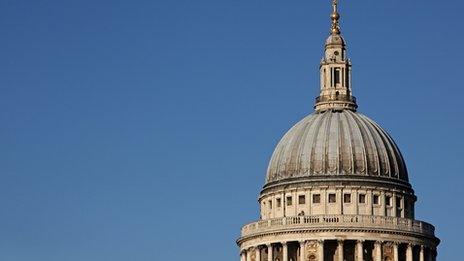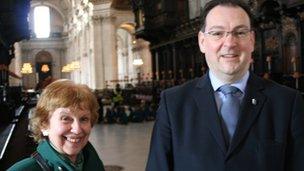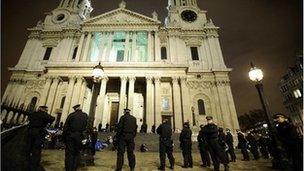St Paul’s Cathedral 'more than a big white building’
- Published

During World War II, Winston Churchill ordered that St Paul's should not succumb to Nazi bomb attacks
Its dome is internationally recognisable. It has hosted some of the most important moments in British history, from the state funeral of Sir Winston Churchill to the wedding of the Prince of Wales and Lady Diana Spencer.
But despite its 1,400 years of history, it is the four-month period when protesters pitched tents outside in the name of subverting corporate greed that most recently shoved St Paul's Cathedral into the public glare.
Images of Occupy London campers outside the vast white Portland stone Baroque frontage were beamed around the world.
"People think it is just a nice big white building", says Graham Way, 52, a volunteer.
"It is, but there's a lot more going on. It's not a great white elephant by any manner of means."
'Close-knit community'
Media coverage failed to give a complete picture, argues Mr Way.
"There's a whole body of people that people have ignored - the staff, volunteers and community of the cathedral," he said.
It was almost as if the cathedral was an empty shell which it most definitely isn't.

Brenda Deane and Graham Way say they aim for people to leave the cathedral in a better frame of mind
"People don't think of St Paul's as a close-knit community but it most certainly is."
Brenda Deane, 81, from the Barbican in the City of London, is just one example.
Every Sunday morning she can be found wearing a red sash gathering the collection from a congregation of up to 40 taking early communion.
"There are about 10 who come regularly and if people don't come we get quite worried," she said. "We've now exchanged email addresses."
The red collection bags she uses are about 90 years old and she sometimes takes them home to stitch their linings.
Miss Deane has been going to St Paul's for 36 years.
Cavernous dimensions
Her father, Noel Deane, was a firewatcher tasked with putting out incendiaries that landed on the roof during the Blitz.
The cathedral was a potent symbol of hope during World War II and then Prime Minister Winston Churchill ordered it should not succumb to Nazi bomb attacks.
In total, there are between 300 to 500 people who offer their time for free including 150 cathedral volunteers like Miss Deane, 60 wandsmen, who are ushers during services, plus bell-ringers and flower arrangers.
There are four daily services and five on Sunday.

The community of the cathedral was 'ignored' when protesters camped outside, said Graham Way
Despite the cavernous dimensions of the structure, volunteers say they know when someone needs help.
"When you are on duty as a volunteer there is always a priest around so if somebody comes distressed we find them and help them," says Miss Deane.
Mr Way, who serves during Mass and also takes tours around the cathedral, has been going to St Paul's for 25 years, from his home in Tunbridge Wells.
"People come here for a reason, in sadness and happiness," he said.
"They might be desperate or lonely and it's our job to make sure when they leave the cathedral they do so in a different frame of mind."
He points out that there is a range of areas people can get involved with, including the choir school, the Friends of St Paul's, the St Paul's Foundation, the St Paul's Institute and the less lofty cathedral pub, The Cockpit, where meetings are sometimes held.
- Published25 March 2012
- Published28 February 2012
- Published28 February 2012
- Published1 November 2011
- Published16 October 2011